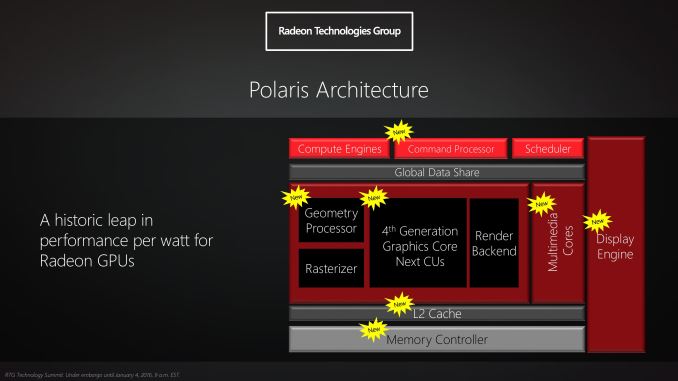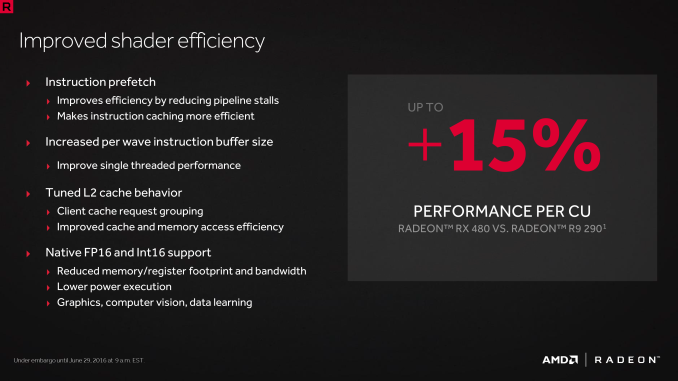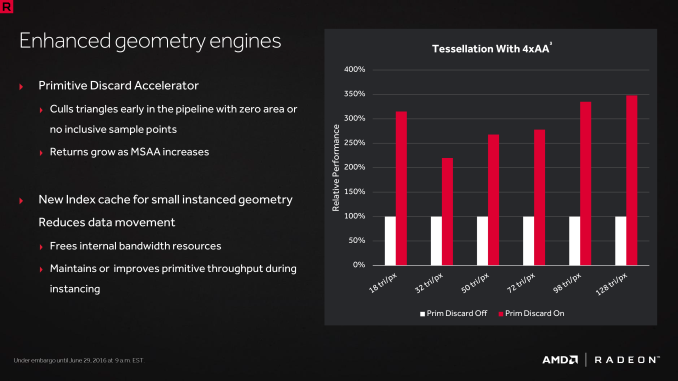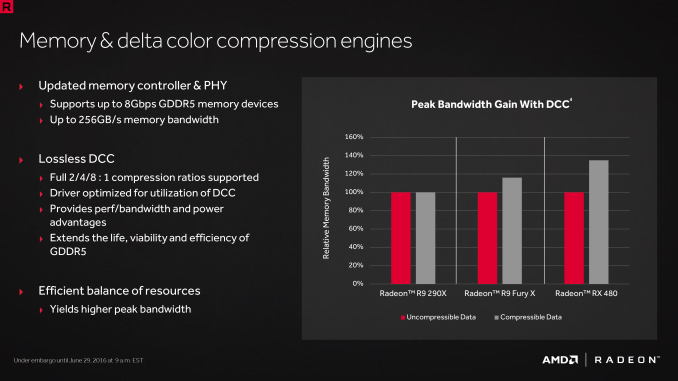The AMD Radeon RX 480 Preview: Polaris Makes Its Mainstream Mark
by Ryan Smith on June 29, 2016 9:00 AM ESTThe Polaris Architecture: In Brief
For today’s preview I’m going to quickly hit the highlights of the Polaris architecture.
In their announcement of the architecture this year, AMD laid out a basic overview of what components of the GPU would see major updates with Polaris. Polaris is not a complete overhaul of past AMD designs, but AMD has combined targeted performance upgrades with a chip-wide energy efficiency upgrade. As a result Polaris is a mix of old and new, and a lot more efficient in the process.
At its heart, Polaris is based on AMD’s 4th generation Graphics Core Next architecture (GCN 4). GCN 4 is not significantly different than GCN 1.2 (Tonga/Fiji), and in fact GCN 4’s ISA is identical to that of GCN 1.2’s. So everything we see here today comes not from broad, architectural changes, but from low-level microarchitectural changes that improve how instructions execute under the hood.
Overall AMD is claiming that GCN 4 (via RX 480) offers a 15% improvement in shader efficiency over GCN 1.1 (R9 290). This comes from two changes; instruction prefetching and a larger instruction buffer. In the case of the former, GCN 4 can, with the driver’s assistance, attempt to pre-fetch future instructions, something GCN 1.x could not do. When done correctly, this reduces/eliminates the need for a wave to stall to wait on an instruction fetch, keeping the CU fed and active more often. Meanwhile the per-wave instruction buffer (which is separate from the register file) has been increased from 12 DWORDs to 16 DWORDs, allowing more instructions to be buffered and, according to AMD, improving single-threaded performance.
Outside of the shader cores themselves, AMD has also made enhancements to the graphics front-end for Polaris. AMD’s latest architecture integrates what AMD calls a Primative Discard Accelerator. True to its name, the job of the discard accelerator is to remove (cull) triangles that are too small to be used, and to do so early enough in the rendering pipeline that the rest of the GPU is spared from having to deal with these unnecessary triangles. Degenerate triangles are culled before they even hit the vertex shader, while small triangles culled a bit later, after the vertex shader but before they hit the rasterizer. There’s no visual quality impact to this (only triangles that can’t be seen/rendered are culled), and as claimed by AMD, the benefits of the discard accelerator increase with MSAA levels, as MSAA otherwise exacerbates the small triangle problem.
Along these lines, Polaris also implements a new index cache, again meant to improve geometry performance. The index cache is designed specifically to accelerate geometry instancing performance, allowing small instanced geometry to stay close by in the cache, avoiding the power and bandwidth costs of shuffling this data around to other caches and VRAM.
Finally, at the back-end of the GPU, the ROP/L2/Memory controller partitions have also received their own updates. Chief among these is that Polaris implements the next generation of AMD’s delta color compression technology, which uses pattern matching to reduce the size and resulting memory bandwidth needs of frame buffers and render targets. As a result of this compression, color compression results in a de facto increase in available memory bandwidth and decrease in power consumption, at least so long as buffer is compressible. With Polaris, AMD supports a larger pattern library to better compress more buffers more often, improving on GCN 1.2 color compression by around 17%.
Otherwise we’ve already covered the increased L2 cache size, which is now at 2MB. Paired with this is AMD’s latest generation memory controller, which can now officially go to 8Gbps, and even a bit more than that when oveclocking.














449 Comments
View All Comments
Demibolt - Friday, July 1, 2016 - link
Not here to argue, just fact checking.GTX 970 is currently in the top 3 cards used by Steam users (according to Steam's reports).
The GTX 970 can currently be purchased for ~$240 from several online retailers.
TimAhKin - Wednesday, June 29, 2016 - link
The 480 was never meant to compete with Pascal.This card is for people that want to upgrade from older GPUs. It's a pretty cheap card that's good for 1080p and VR.
Fallen Kell - Wednesday, June 29, 2016 - link
This is a horrible card for VR. It can barely do 60 FPS at 1080p, which isn't even in the same ballpark of doing the 90-120 FPS at 2160x1200 that is needed for VR. The card would need to be 3-4x higher performance than it currently is to pull off VR.Meteor2 - Wednesday, June 29, 2016 - link
No, you need 90 fps minimum for VR and the 480 does it at the resolutions used by the Rift and Vive just fine.DigitalFreak - Wednesday, June 29, 2016 - link
The 480 does 90fps @ 2160x1200? WTF are you smoking?Fallen Kell - Thursday, June 30, 2016 - link
I know, seriously. I don't know what Meteor2 or TimAhKin are smoking, as it is obviously the fanboy weed. There is only a single game that was benchmarked at 1080p where the 480 could even hit 90+ fps, and everything else was between 40-70 fps. And VR has 25% more pixels than 1080p.I mean, if the 480 was getting 120-130 fps at 1080p, then I would agree that it might be a decent VR card. But it averages about 1/3rd that on current AAA titles (or less with highest video quality settings enabled). This is why I said it needed to be 3-4x higher performance than what it is to do VR. Anyone using this for VR will have to turn down the video quality WAY down, which means you will see much more item/object popping due to object draw distances being so low, which destroys the immersion sense that VR is attempting to create in the first place. Add in the slideshows you will get during effects heavy scenes and get ready for the vomit comet to commence due to the eyes not seeing the results of your head moving.
Meteor2 - Thursday, June 30, 2016 - link
I'm going by the Occulus benchmarks. You know, the one by the people who make the VR headsets.killeak - Thursday, June 30, 2016 - link
Well, they said that this would be an entry level VR card, and for that I take using low settings but 90fps at VR Resolution, and I think it's possible to consider the RX 480 (just as the 970) an entry level VR card.Now, if we are talking high/ultra settings, then no, it won't make it.
pashhtk27 - Thursday, June 30, 2016 - link
And for 90fps on high settings, you have 1080. You sure should smoke cash.Yojimbo - Thursday, June 30, 2016 - link
You are looking at benchmarks with all settings maxed out. The RX 480 is entirely capable at running 90fps @ 2160x1200 with settings selected more judiciously.